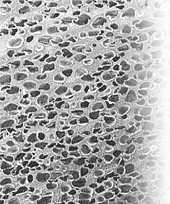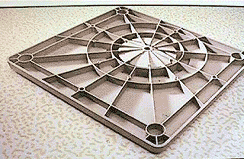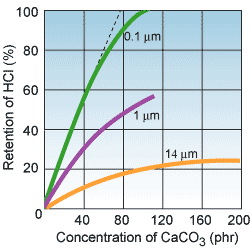#1 PCC in Rigid PVC
Pressure Pipes
 Coated ultrafine precipitated calcium carbonate can be included in formulations intended for use in pressure pipe applications where the addition of 2-3 phr will improve the processing properties and ensure more complete gelation. At this level of inclusion, the hoop strength of the pipe is retained without other adverse behavior.
Coated ultrafine precipitated calcium carbonate can be included in formulations intended for use in pressure pipe applications where the addition of 2-3 phr will improve the processing properties and ensure more complete gelation. At this level of inclusion, the hoop strength of the pipe is retained without other adverse behavior.
Plate out is also reduced due to the improved dispersion of lubricants and other additives used in the formulation.
Some specifications limit the inorganic content of such formulations and under these circumstances, the limit of addition may be only 1 phr. However, even at this level, beneficial processing effects can be observed.
The addition of higher levels of any calcium carbonate into pressure pipe formulations is not recommended due to the reduction in tensile strength which can adversely affect the burst pressure of the pipe.
|
Indicative Formulation
|
|
S-PVC, K-value 68
|
100
|
|
CPCC
|
1-2
|
|
Pigment
|
X |
|
Stabilizer one pack
|
2-3
|
Rigid PVC Foam
 The use of coated precipitated calcium carbonate provides a unique combination of beneficial processing properties in rigid cellular PVC. In order to obtain an optimum level of density reduction, formulations need to feature a compromising set of melt properties.
The use of coated precipitated calcium carbonate provides a unique combination of beneficial processing properties in rigid cellular PVC. In order to obtain an optimum level of density reduction, formulations need to feature a compromising set of melt properties.
The melt strength and elasticity have to be high, but the melt viscosity should be low. Without these rheological characteristics, the generated gas cannot be retained, and cell structure will collapse forming voids and even surface bubbles.
Coated precipitated calcium carbonate has the effect of providing melt reinforcement which manifests itself as improved
melt elongation and elasticity. Some benefits in rapid set-up after the die together
with possible nucleation effects have also been observed.
The benefits offered by PCC in rigid PVC applications are mentioned below:
- Melt rheology improvement results in improved melt extensibility which reduces
the need for high levels of expensive processing aids.
- More efficient dispersion and distribution of all additives including blowing agents
allowing a possible reduction in phr of these additives.
- Coated precipitated calcium carbonate as a nucleating agent.
- Significant improvement in impact strength.
- Improved surface finish.
Injection Molding
 The inclusion of coated ultrafine precipitated calcium carbonate in rigid PVC formulations improves the processing behavior by increasing the rate of gelation and improving melt behavior.
The inclusion of coated ultrafine precipitated calcium carbonate in rigid PVC formulations improves the processing behavior by increasing the rate of gelation and improving melt behavior.
Such compounds exhibit improved melt reinforcement and elongation which enables the PVC to withstand the shear gradients seen in injection processing which would otherwise give rise to surface defects caused by melt fracture.
Elimination of gates marks from the molding process which is again a desirable quality improvement.
Improved and more homogeneous gelation promotes optimum physical properties and improves impact strength properties
Processing aids tend to increase the melt viscosity which reduces mold flow, spiral flow testing of formulations. While using CPCC show a reduced melt viscosity in comparison to formulations based on traditional processing aids.
|
Formulation with Process aid/GCC
|
Formulation with CPCC
|
|
PVC K value 57-60
|
100
|
PVC
|
100
|
|
Stabilizer system
|
X
|
Stabilizer system
|
X
|
|
Process aid
|
2
|
Process aid
|
0.5
|
|
1 micron GCC
|
3
|
CPCC
|
6-8
|
Extrusion Profiles
 When formulated into extrusion profile PVC compounds, coated precipitated calcium
carbonate improves:
When formulated into extrusion profile PVC compounds, coated precipitated calcium
carbonate improves:
- Gelation and processing
- Surface finish
- Impact resistance
Reversion is minimized and profiles retain their mechanical properties
under weathering conditions.
CPCC is a unique additive which can provide both a processing aid and impact modification
function without any of the adverse effects that can be normally experienced i.e. high melt viscosity/die swell and poor reversion values when using conventional
additives.
Most formulations contain organic impact modifiers to achieve high impact strengths. However, these products modify the physical properties of the PVC but also have to be used at high loading which has a negative effect on the processing melt rheology and surface finish properties.
CPCC used to replace the natural calcium carbonate in the formulation improves all the processing properties and allows a reduction in impact modifier and process aid levels.
|
Extruder conditions
|
Variable dosing
rpm
|
% Die well reduction
CPCC versus GCC
|
|
KMD 125, 3 mm Rod
Temp. profile: 190/191/190/190
|
10
20
30
|
16
15.8
15.4
|
The surface finish of extruded profiles can be very important i.e. window systems,
and the incorporation of CPCC provides a high gloss, high integrity surface finish
without the need for additional effort i.e. heated calibration stage.
The ultrafine particle size of the synthetic calcium carbonate and the melt reinforcement
effect is the explanation for this observation.
Impact Strength
The addition of coated ultrafine precipitated calcium carbonate substantially improves
the impact strength of rigid PVC. This improvement is noted over a range of temperatures
including below 0°C which is beyond the capability of conventional organic impact
modifiers. Such is the improvement, that some window profile systems based on specific
PVC types rely on the CPCC for their mechanical properties with no added organic
modifier in the formulation.
It is more common however to utilize a combination of organic impact modifiers together
with CPCC to obtain the necessary mechanical properties at the most cost-effective
level of modifier addition.
These beneficial effects are noted with all types of impact modifiers in combination
with PVC homopolymer and also with PVC copolymer-based systems.
The figure below shows that, although the optimum effect of Winnofil® S is achieved
at 10-15 parts addition, substantial improvement in impact strength is still obtained
with higher levels. However, from a processing viewpoint, additions of more than
15 parts are above the optimum and the proportion generally advised for most applications
is up to 10 parts.
Effect of Varying the
Proportion of Winnofil® S on the Impact Strength of Rigid PVC
Tested as pipe at 0°C and as a sheet at -10°C. Test method:
Falling weight
The figure below shows the beneficial effect of Winnofil® S in combination with an acrylic
impact modifier. A cost/performance compromise is to employ 5-10 phr of the organic
modifier with 10 phr of Winnofil® S when the effect on impact strength is considerably
higher than using either additive alone.
Effect of
Winnofil® S in Combination with Acrylic Impact Modifier on Rigid PVC
Extruded Part
Test method: falling weight at -40°C
Reversion
This area is concerned about the stability of the profile after extrusion. The more
under-processed a profile, the greater the instability to heat. "Winnofil®",
because of its small particle size gives more homogeneous melt in the extruder.
For a given phr these are 1000 more CPCC particles in the melt than GCC.
This allows the PVC to be thoroughly worked during processing giving faster gelation
times and more stable profile. The following results were obtained from industrial
trials where a Ground and modified formulation were tested at the same conditions.
|
Formulation
|
% Reversion
|
Rate
m/min
|
Single V Notch
Charpy impact at 23°C (kJ/m2)
|
|
TOP
|
BOTTOM
|
|
Ground filler system
|
1.87
|
2.02
|
1.1
|
14.0
|
|
Precipitated CC
|
1.57
|
1.67
|
1.1
|
Hinge Break
|
Formulations
The table below shows an alternative formulation with CPCC, providing at least 5% cost savings.
|
|
Formulation
with GPP
phr
|
Alternative
with CPCC
phr
|
|
PVC
|
100
|
100
|
|
1 Pack |
4.3
|
4.3
|
|
Process aid
|
1.5
|
0.5
|
|
TiO2
|
4
|
4
|
|
GCC
|
5
|
-
|
|
Winnofil® S / Socal® 312
|
-
|
8
|
|
Impact modifier
|
7
|
5
|
CPVC Extrusion
There are requirements for PVC compounds, which have high heat distortion temperatures, and where also medium/high impact strength is required. These are often formulated from chlorinated PVC resins (CPVC) and impact modifiers.
The melt extrusion behavior of such compounds can prove difficult due to the rheology of the compounds from these resins and additives and often a poor surface finish is observed. The inclusion of CPCC will dramatically improve the surface finish and increase the impact strength such that impact modifier levels can be reduced.
CPVC Pipe Containing 6 phr of CPCC
Formulations Containing PCC
The incorporation of coated precipitated calcium carbonate is influenced by the final target density to be attained. However, levels of 2-8 phr CPCC are successfully incorporated into rigid PVC foam allowing both processing aid and impact modifier levels to be significantly reduced.
The table below shows two examples of formulations containing CPCC. One for 2-dimension expansion
and another for Free Foam.
|
2 dimensions expansion
|
Free Foam
|
|
|
phr
|
|
phr
|
|
PVC
|
100
|
PVC
|
100
|
|
Stabilizer
|
3-4
|
Stabilizer
|
2.5
|
|
Process Aid / Modifiers
|
8
|
Process Aid / Modifiers
|
6
|
|
Winnofil® S
|
3-6
|
Winnofil® S
|
3-6
|
|
NaHCO3
|
2.5
|
Azodicarbonamide
|
0.3
|
|
TiO2
|
5
|
TiO2
|
4
|
Check out the precipitated calcium carbonate for rigid PVC applications
#2 Applications of PCC in Plasticized PVC
Coated synthetic ultrafine calcium carbonate can provide valuable property modifications
in a range of flexible PVC applications. The ultrafine nature of the synthetic carbonate
and the fatty acid surface treatment enable the CPCC to be readily wetted out during
compounding for the full activity of the high surface area to be realized.
The major benefits from using CPCC in plasticized PVC are discussed below:
- High surface gloss
- Smooth surface finish and white scratch marking resistance
- Resistance to white flex marking
- Efficient HCl acid gas absorption
Cable Compounds
CPCC is used in both insulation and cable sheathing where it provides a high gloss
finish and retained good electrical properties. Typical formulation and results are
summarized in the table below.
|
|
Part by weight
|
|
|
Insulation
|
Sheath
|
|
PVC Polymer
|
100
|
100
|
|
DOP
|
25
|
60
|
|
Cereclor S52
|
25
|
60
|
|
Winnofil® S (CPCC)
|
50
|
100
|
|
TBLS
|
6
|
6
|
|
Calcium Stearate
|
1
|
1
|
|
Bisphenol A
|
0.25
|
|
|
Properties
|
Before immersion in water
|
24 hours at 23°C in Water
|
|
Volume resistivity (ohm-cm x 1014) |
2.6
|
1.4
|
|
Power Factor (at 1000Hz)
|
0.084
|
0.10
|
|
Permittivity (at 1000 Hz)
|
5.0
|
5.5
|
The most significant interest concerning the utilization of CPCC in cable compounds
relates to the ability of the high surface area CPCC to effectively retain HCl gas
released under a combustion situation.
Practical cable formulations have been developed
that rely on this high surface area activity of synthetic calcium carbonate for
HCl capture and in combination with other additives, this allows workable formulations
for use in this sector.
 Effect of Filler Level on Retention of HCl During the Combustion
of PVC
Effect of Filler Level on Retention of HCl During the Combustion
of PVC
Typical Flame retardant PVC cable formulations with low HCl emission and properties
are given in the table below.
|
Formulation
|
A
|
B
|
C
|
|
PVC Polymer
|
100
|
80
|
60
|
|
Hycar
|
-
|
20
|
40
|
|
Triarylphosphate
|
35
|
35
|
35
|
|
Plasticizer
|
22
|
22
|
22
|
|
Winnofil® S
|
60
|
60
|
60
|
|
ATH
|
60
|
60
|
60
|
|
Heat stabilizer
|
6
|
6
|
6
|
|
Paraffin wax
|
1
|
1
|
1
|
|
Properties
|
|
Oxygen index
|
36
|
33
|
31
|
|
Emission of HCl (%theorical)
|
8
|
4
|
2
|
|
Tensile Strength, (MPa)
|
25
|
8
|
6
|
|
Elongation at break
|
160
|
315
|
470
|
|
Volume resistivity, ohm-cm x 1012
|
4.8
|
2.8
|
0.4
|
|
Cold Bend Temperature, °C
|
5
|
-15
|
-25
|
Flame Retardant PVC Cable Formulations
#3 More Specialty Applications of PCC
Thermosets
Certain grades of PCC offer benefits in rheology control in polyester molding compounds
where the bright color, positive effect on the viscosity and much improved surface
finish and sandability are valuable property improvements.
The figures below show the particular effects that the fineness, the crystal structure
and the free-flowing density have on the viscosity of the polyester resins.
Influence of
Free-flowing Density of Socal® on Viscosity and
the Yield value of Mixtures Socal® Polyester (50:50)
Viscosity of
Mixtures Socal® /polyester (40:60) in the Function
of the Mean Diameter of Socal® and the Crystal Structure
Liquid Resins
Due to its ultrafine particle size and hydrophobic surface treatment, CPCC allows improvements in the control of the rheology in a range of liquid resin systems. The mechanism of effect results from the hydrophobic/hydrophilic balance of fatty surface treatment and the flocculated nature of the crystalline structures present in the product.
Grades are easily dispersed in a liquid system and the rheological
effects do not require further addition of synergists or activators to be effective.
Improved viscosity stability can be seen with time when compared to the use of other
rheological control agents and CPCC presents fewer handling problems in use.
Thermoplastics
In polyolefins, CPCC is used as an acid scavenger. Beneficial properties are also seen in polyolefin compounding
where low-level addition of the high surface area grades will improve the anti-blocking
properties of thin-film applications.
Where injection moldings are produced from PE or PP, Socal® increases
service temperature and gives the materials a high degree of brightness. The adding
of 2 % to 4 % by weight makes PP film easier to splice while, at the same time,
reducing PP deposits on fast-moving machine parts.
In polystyrene, the use of up to 30% by weight of Socal® increases
impact resistance, as well as reduces the use of TiO2
Free-flow Agent for Powders
Coated ultrafine PCC acts to improve the flow properties of problem powders. The
beneficial effect is seen when either the product is added into the final stages
of a production stream as in the case of spray drying isolation or alternatively
the CPCC can be added into a final product mix.
The free flow and anti-caking improvements
seen require only 1-2% addition of the high surface area CPCC which helps to coat
the surface of the bulk material reducing interparticle attractions. There is also
a positive effect on the absorption of moisture from the particle interfaces, which
also assists in the anti-caking and free powder flow improvements observed.
Liquid Carrier
The relatively high surface area of PCC can allow these products to be used as inert
carriers for liquid catalysts.
One example of this is where reactive organic peroxides
can be absorbed onto the calcium carbonate, allowing the production of an easy-to-handle catalyst paste for use in combination with reactive liquid resin components.
The calcium carbonate has no adverse effect on any of the adhesion properties, which
can be adversely affected by other thixotropic control agents.